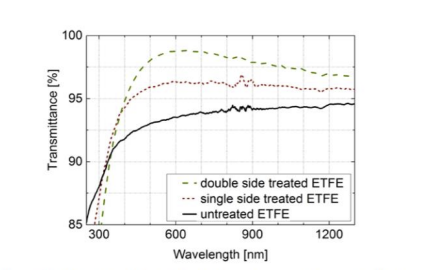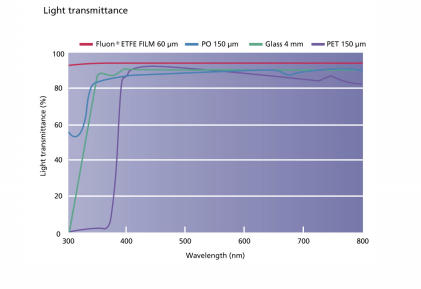I agree that binning is important to maximize output of solar cells.
Very great and inspiring project.
Thanks for sharing the videos.
Gladly more of it.
Sailing is just awesome.
I read a research paper where they were testing ETFE film for solar cars and had up to 96% transmittance. It has 12 and 25 micron versions. Issue is that it is sold in 1000 meter rolls so trying to find resellersif the manufacturer does not want to sell to me. The 12 micron is single sided plasma treated by default. I have not seen double sided plasma treated available commercially but they were provided a sample for their research paper. (https://digital.library.adelaide.edu.au/dspace/bitstream/2440/122782/1/Alghamdi2019_MaCoursework.pdf)
I am wondering how this would work compared to oracover air which is a polyester shrink film.

Hello, I am researching solar cells in rc airplanes, I am interested in mounting cells on the wing of my Ranger 757-3, I have to get the calculation but about 20 c60 cells should enter, maybe making a new wing with a larger surface area I can get close 40 cells maybe. Do you think it would be good to accompany the cells with a GV-5? I use 4s 2x 5200mah lipos, that is 4s 10Ah, I don’t know whether to choose the gv5 or the gv10, the gv10 seems a bit heavy to me, but I would like to know your opinion since you know more about this subject! Greetings from Argentina!
Hi Santi_Cavallo,
Key is to keep things light and current consumption low. Try to build an airplane that consume half or less of your available solar power, and then fly it with battery for an hour or more. Then you are ready to install solar cells. You can remove the case of GV5 and GV10 also remove terminal screws and solder cables directly on PCB to reduce weight. But you are right that GV10 are heavier that were why I decided to go with GV5 . I would also use NCR18650GA or similar cells instead of lipo to keep weight down. I started as a noob and it took me three years of spare time to build, test, fail, improve, and then repeat many times to succeed with my solar airplane. Good luck with your endeavor!
Can anyone please tell me the thickness of the wing?
Hi Samin,
I needed to use slim servos TGY-S712G in the wing, they are 10mm thick. I guess the outer wing is approximately 14-16mm thick at alieron position outer wing. The inner wing is thicker. I can get back to you with a measured value in a week. I investigated the possibility for placement of 18650 cells in the center wing. But the spar and rib placement and wiring would create a mess. After all it were a solar project. The solar cell are very thin 0.2mm and extra covering 0.065mm
Hi there, I’m working on a solar self-sustaining pseudosattelite, and I was wondering if you’d like to help out - your expertise would certainly be greatly appreciated. Shoot me an email at keatonhare@gmail.com, and I’d love to ask you some questions at the very least
Great work on the project. I am currently working on something similar and was wondering if you had a wiring diagram? I want to compare mine to something to make sure I am not making any obvious mistakes. Thanks.
Hi, Owen
I don’t have a wiring diagram. I connected the Solar RC plane as any other plane with Ardupilot. The only addition was that the solar panels were connected to the Genasun GV-5 MPPT stepdown controller and that were connected to the 4s 18650 battery. The one thing that can mess things up is that the GV-5 MPPT are switching on the low side (GND). This means the high side (plus) are shorted between input and output. Not as many are used to that the GND are common between input and output and the high side (plus) are switching.
Also, to save weight and complexity I removed the camera, video transmitter, flaps, airbrakes, and extra current sensors. Tried to reduce cable length and weight (by reducing size). I used the solar panels as wire with the exemption on the outer wings with only one row of panels. I even used the wing attachment bolts as conductors.
Daniel (rctestflight) explains the low side switch in an easy way in his video “Solar Plane V4 Cross-Country Waypoint Mission” at 6.23
Thank you.I am also curious how many watts the panels make even with the film over them. Does it really make a difference?
I never was able to measure the effect of the covering film I used with any accuracy (one estimate I used was 0.85). But the solar film was only one of the reductions in the power from the solar cell to the motor. Some losses in no order: latitude 60 degrees 0.8, angle error level wing 0.6, covering 0.85, stepdown MPPT 0.9, electronic 6W So quick calculation gives: 3.4Wx35 cells = 119W * 0.8 * 0.6 * 0.85 * 0.9 – 6W = 38W
Updated link to dataflash log (Warning size is 800MB): Access via Synology
Like your project. ![]()
Was there any component which appeared very hot after the long flight? (motor,ESC, RC,…)
No, parts were hot after 7h flight. But if you check the temperature of the airspeed sensor ambient air peaked at 20 degrees C. One of the advantages at my latitude.
Only 38W for the motor? How much did it draw when gliding?
Maybe I misunderstood, but the motor draws 0W when gliding ;-). As stated before in I estimated that the plane consumes 25-45W at level flight.
@magnus1089
Is it possible that you reupload the first log file which you post in the first post at the beginning of the thread?
i would like to go through the data? Thank you very much.
I was unable to update the orignal post. Updated link to the first flight of 300km: http://gofile.me/6ZPyY/1rjTsmQac